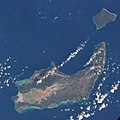Inagua
District in Great Inagua, Bahamas From Wikipedia, the free encyclopedia
Inagua is the southernmost district of the Bahamas, comprising the islands of Great Inagua and Little Inagua. The headquarters for the district council are in Matthew Town.[2]
District of Inagua | |
|---|---|
District | |
 | |
| Country | Bahamas |
| Island | Great Inagua |
| Government | |
| • Type | District Councils |
| • Chief Councillor | Kennard Rolle |
| • Deputy Chief Councillor | Dometrius Taylor |
| • Island Administrator | Herman Gilbert |
| Area | |
• Total | 1,679 km2 (648 sq mi) |
| Population (2022) | |
• Total | 856[1] |
| Time zone | UTC−5 (EST) |
| • Summer (DST) | UTC−4 (EDT) |
| Area code | 242 |
History
Summarize
Perspective
The original settlers were the Lucayan people(Taíno), who arrived sometime between 500 and 800 CE, crossing in dugout canoes from Hispaniola and/or Cuba to the Bahamas.[3]
The larger island was initially called by the name Heneagua, which may derive from a Spanish expression meaning 'water is to be found there'.[4] Two names of apparent Lucayan origin, Inagua (meaning "Small Eastern Island") and Baneque (meaning "Big Water Island"), were used by the Spanish to refer to Great Inagua.[5][6][7]
Between the years of 1500 and 1825, many documented treasure laden ships were destroyed on Inaguan reefs. The two most valuable wrecks lost off the Inaguas were treasure-laden Spanish galleons: the Santa Rosa in 1599; and the Infanta in 1788. Other ships of considerable value that were wrecked there include the French Le Count De Paix in 1713,[8] the British HMS Lowestoffe in 1801,[9][10] and the British HMS Statira in 1815.[11]
As early as the 1600s, salt was being produced and shipped to Spanish colonies,[12] and its extraction was a going business by 1803.[12]
Henri Christophe, king of northern Haiti from 1811 to 1820, built[when?] a summer retreat at the Northeast Point of Great Inagua.[12] Local legend has it that he also buried a cache of gold there.[13]
By 1918, after the end of World War I, lower salt prices and competition had driven the small producers on Great Inagua out of business, and the salt works were abandoned except for incidental local use.[14]
In 1935, the Erickson brothers from Massachusetts founded West India Chemicals Ltd., purchasing the abandoned salt works from the British government.[15] They drilled test holes, set up offices, and began restoration of the buildings, but the locals[16] felt threatened, fearing changes to the power structure status quo.[17] In August 1937, a riot broke out, an employee was killed, and the Ericksons were forced to flee.[18][19] They soon returned, and full-scale development resumed.[20]
In the mid-1950s, Morton Salt bought the Great Inagua saltworks,[21] which includes over 80 salt ponds,[22][self-published source] now the second largest such operation in North America.[20] Morton is the major employer on the island.[23][24][25]
Islands
Summarize
Perspective
Great Inagua
Great Inagua is the second largest island in the Bahamas at 596 sq mi (1544 km2), it is 4 times smaller then Andros, the largest island in the Bahamas.[citation needed] It lies about 55 miles (89 kilometres) from the eastern tip of Cuba. The island is about 55 by 19 mi (89 by 31 km) in extent and mostly flat with some sand hills, the highest points being East Hill at 132 ft (40 m), Salt Pond Hill at 102 ft (31 m), and James Hill at 90 ft (27 m).[4] It encloses several lakes, most notably the 12-mile (19 km) long Lake Windsor (also called Lake Rosa) which occupies nearly a quarter of the interior. The population of Great Inagua is 913 (2010 census).[26]
The island's capital and only harbour is Matthew Town, named after George Matthew, a 19th-century Governor of the Bahamas. This town houses the Morton Salt Company’s main facility, producing one million tonnes of sea salt a year — the second largest solar saline operation in North America and Inagua's main industry.[citation needed]
Great Inagua Airport (IATA: IGA, ICAO: MYIG) is located nearby.[27][28]
A large bird sanctuary in the centre of the island has a population of more than 80,000 West Indian flamingoes and many other bird species, including the Bahama parrot, Inagua woodstar, Bahama pintail, brown pelican, tricolored heron, snowy egret, reddish egret, stripe-headed tanager, double-crested cormorant, Neotropic cormorant, roseate spoonbill, American kestrel, and burrowing owl. The Union Creek National Reserve is specially set aside for the study of green sea turtles (Chelonia mydas).[29][30]
Little Inagua
The neighbouring Little Inagua, 8 km (5 mi; 4 nmi) to the northeast, is uninhabited and occupied by a large Land and Sea Park.[29] It has an area of 30 sq mi (78 km2), with herds of feral donkeys and goats (descendants of stock introduced by the French). Various species of endangered sea turtles breed on the island.[29] Little Inagua has a large protective reef extending up to 1 mile (1,600 m) away from the island in all directions, which prevents boats from coming too close.[citation needed]
Politics
The island is part of the MICAL constituency for elections to the House of Assembly of the Bahamas.[31]
Gallery
- Main Guest House in Matthew Town, Great Inagua
- Downtown Matthew Town, Great Inagua
- Old disused prison, Matthew Town, Great Inagua
- Window in old prison, Matthew Town, Great Inagua
- Modern police station, Matthew Town, Great Inagua
- Grocery store in Matthew Town, Great Inagua
- Part of the Morton Salt facilities on the north shore of Great Inagua
- Northern rocky shore of Great Inagua exposing Pleistocene reef limestones
- Great Inagua and Little Inagua viewed from the International Space Station on 2022-12-09
Notes
Further reading
External links
Wikiwand - on
Seamless Wikipedia browsing. On steroids.









